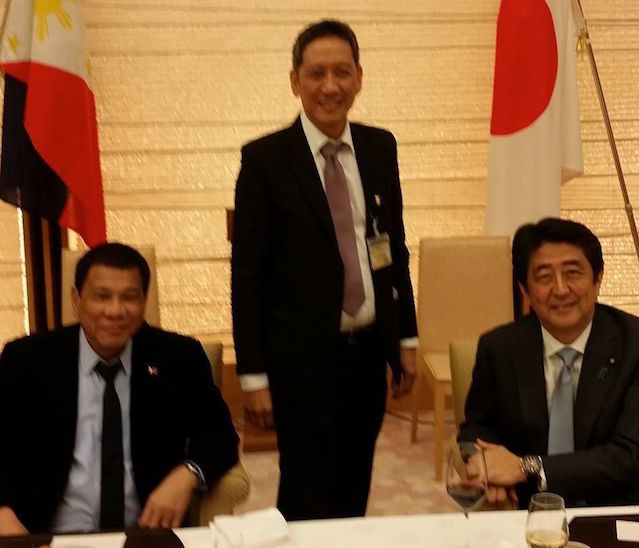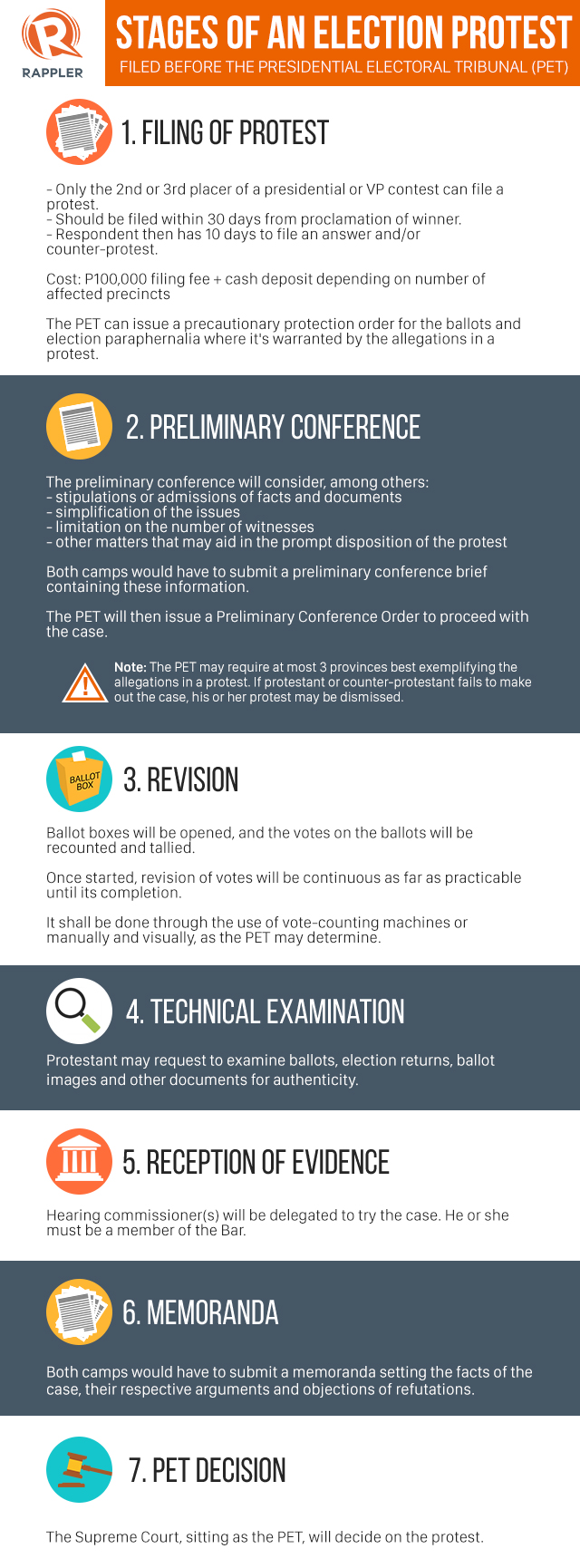The cathedral is lit in neon. Seventy-one feet of cement and adobe glow red and aquamarine and purple and blue. The spotlights change hue at half-second intervals. Colored stars dot the soaring walls. Potted shrubs strangle under strings of lights. The effect is a cross between a circus sideshow and a psychedelic dream, Lucy in the sky blinking over the gathered faithful at the church steps.
This is the Shrine of Our Lady of Perpetual Help, the Redemptorist Church of Baclaran, at 4:30 in the morning the week before Christmas, shining high and bright along Roxas Boulevard. The pews are filled end to end for the dawn mass. Hundreds more crowd the doors and vestibules.
Down the main road, behind vendors hawking coffee and cheese waffles and Tender Juicy Hotdogs at P20 a stick (P30 with bun), fluorescent-lit three-foot photographs are installed on metal poles. The images march on both sides of the church road. The body sprawled under the streetlight. The masked cop carrying an M-16. The corpses shoved into the gutter. The purple-red ambulance lights on the face of the screaming daughter. The woman holding the dead husband. The crowds behind the yellow tape. Blood on the ground, bullets circled in chalk, the cardboard signs scrawled with pusher and addict.
The crowd streams by, mothers hauling toddlers, couples armed with selfie sticks, clusters of extended family holding hands in the dark.
“What is that? –”
“– shot by –”
“The ones who were killed –”
“They’re addicts.”
“Probably addicts –”
“Poor women – but that’s the life of an addict.”
“What if your daughter was raped by an addict?”
“There was this body on our street a week ago–“
“So much blood.”
“–some of them were just in the wrong place.”
“They’re anti-Duterte.”
“–those poor people–“
“Why on Christmas?”
Inside the church, under thousands of tiny lights, the priest tells a story. He speaks of Mary, who carried God’s word in her womb, and yet feared the coming of his passion and death. He speaks of John the Baptist, executed by the hand of King Herod. He speaks of Jesus, who understood sin.
“Let us open our hearts,” he said. “The image that we face this Christmas is around us. We cannot deny that our country is suffering in secret. The image of the holy family is in the image of the victims of extrajudicial killings. They may have sinned, but it is Jesus who forgives.”
The voice echoes throughout the cathedral. Those sitting on the front pews blink at the mention of killings.
“Brothers and sisters, let us open our hearts to the prayer and mourning of the mothers who have lost their children.”
{source}
<div class="blob-full" style="position:relative;">
<bg-image-no-crop style="background: url('http://assets.rappler.com/5A114A0CF6954387940D20206E3550D8/img/B7532F83466748F1A8B5D395ABDC3A9B/CAG-12.jpg');">
</bg-image-no-crop>
</div>
{/source}
A body to bury
The Reverand Father Joseph Echano is a small man, shy, more likely to smile instead of speak. He admits he was uncomfortable with his first appointment as rector. Social functions intimidate him, he says, and so do mayors and bishops. He is more comfortable with his camera, taking pictures of the congregation, or coding html for the shrine’s website – the shrine, he is happy to say, won "Best Website" at the Catholic Mass Media Awards – or doing the daily work of the church.
It was that daily work of the last six months that brought him closer to the killings. In the last six months, since the inauguration of President Rodrigo Duterte, the Redemptorist Church has seen an increase in families pleading for funeral assistance, many of their dead killed in the war against drugs.
Under Echano’s leadership, on the first day of the dawn masses, churchgoers were welcomed by the photographs from the night beat – the corpses, the grieving, the yards of yellow tape. Photos by Patrick Adalin, Czar Dancel, Dante Diosina Jr, Jay Ganzon, Vincent Go, Raffy Lerma, Carlo Gabuco and Brother Jun Santiago of the Redemptorist Church line the pathways. Echano says he did not struggle with the decision. There are truths that must be told, he says, and he has heard from the people themselves.
Since July 1, at least 6,199 have been killed in the war against drugs. As of December 25, the police list 2,150 suspected drug personalities killed during police operations. Victims of extrajudicial killings have run up to at least 4,049. (READ: In the Name of the Father)
The shrine of the Lady of Perpetual Help has long offered funeral assistance to the indigent. In the last six months, the requests for help have risen. According to social mission leader Marivic Listana, over 60 cases of extrajudicial killings have been recorded and assisted by the Church, with burial costs ranging from P3,000 to P40,000.
The priests of the shrine occasionally appear on the graveyard shift of the Manila Police District. They carry their own cameras, take their own notes, stand side by side outside the police lines with the journalists covering the murdered of the last six months. They offer prayers, assistance, counseling, and return to the shrine with stories.
“They are traumatized when they come to us,” says Echano. “They would ask us why, why it had to happen that way. And sometimes, they try to rationalize everything, they say, ‘It would have been better if he were really an addict.’ As if it were okay to kill if the victim was an addict. It’s their way of coping, because they can’t accept what happened yet.”
{source}
<div class="blob-full" style="position:relative;">
<bg-image-no-crop style="background: url('http://assets.rappler.com/5A114A0CF6954387940D20206E3550D8/img/F74F3E26D85849CF89047A78FA36412D/CAG-10.jpg');">
</bg-image-no-crop>
</div>
{/source}
A separate peace
The dead man’s name was Ericardo Medina. He was 23, a jeepney barker. They called him Paborete, a play on the word favorite, as well as on Italian operatic tenor singer Luciano Pavarotti. The story goes that when Paborete was a baby, his screaming reminded his father of Pavarotti in concert. Paborete Medina liked to rap. He liked to sing. He liked to beatbox, and was good with a guitar. They said he had used drugs with his friends when he was sixteen, but never again.
He was abducted on November 17. His body was found the next day along a gutter in Park Avenue, Cuneta.
“You can’t explain how you feel,” says 26-year-old Joy Medina, “because it’s your brother, you’ve known him for so long, and you never expect he’ll be killed that way. We wouldn’t have been hurt so much if he was involved in drugs. But we knew him. He was affectionate, he was mischievous, he was happy. Give him a cup of rice and a bit of food and he’s happy. Give him P20 and he’s happy. He never gives anyone trouble. That’s why what they did to us hurts so much.”
At dawn on November 18, Joy was at her father-in-law’s when she heard the television blaring the casualty count from the night before. Eight killed in Pasay, bodies scattered across the city, faces and wrists wrapped in packing tape. She saw the video roll. She saw a tattoo inked into the back of one of the victims. She went home, called her sister Medelyn, asked her if their brother was dead. None of them were sure. All of them were afraid.
They rushed to the morgue, asked for the body.
“When we saw him, we couldn’t recognize him because there was blood all over his face. We thought his face had been broken. The blood was fresh, like he had been dead around six hours.”
The Medinas were born and raised in a cemetery. Their father was a gravedigger. They knew the families who cremated relatives abandoned the coffins used for wakes, and they begged the crematorium for one in Paborete’s size.
“It hurt us to know that someone else had lain in that coffin. We kept whispering to Paborete, ‘Don’t let your killers sleep.’ We said, ‘Make their lives miserable, let them feel your presence, make them feel what a terrible thing they’ve done.’ We don’t ask for vengeance, to kill his killers, all those things, no. We just pray.”
The family managed to raise a third of the morgue’s costs. They went to the city hall for assistance. They went to welfare office. They went to the mayor’s office. They were told, again and again, to ask help from the Redemptorist Church.
The church paid for part of the burial. They blessed Paborete’s body. They offered counseling, and gave Paborete’s sisters a food stall to run during the dawn masses to help pay for funds the family had borrowed elsewhere.
“We find some peace here,” says Joy. “When we’re here, we don’t think of what our brother went through. It’s when we’re at home that we do. It already hurts when someone pinches you – can you imagine if someone wrapped your face in packing tape and shoved an ice pick into your neck?”
{source}
<div class="blob-full" style="position:relative;">
<bg-image-no-crop style="background: url('http://assets.rappler.com/5A114A0CF6954387940D20206E3550D8/img/39C8CE1A443E49AE93F63F031C0E1E86/CAG-18.jpg');">
</bg-image-no-crop>
</div>
{/source}
A house divided
“Maybe with the small thing we’ve done,” Echano says, “the church will awaken a little that we need to speak, and we don’t have to be silent.”
Over social media, on the public pages of the shrine, at the comment sections of news articles, Echano and his priests have been attacked for hypocrisy – how dare the Church, sinners all, speak on the killings. Bastard priests, demons from hell, members of the yellow cult. Echano and his priests have been called hypocrites and anarchists, rapists and pedophiles, coddlers of drug lords who hear their confessions in an attempt to feed church coffers.
The rector is not the first member of the clergy to oppose the killings, although his shrine may now be the most visible. In August, Pangasinan Archbishop Socrates Villegas released what may have been the strongest statement against the drug war.
"From a generation of drug addicts,” Villegas asked, “shall we become a generation of street murderers?"
Echano concedes there is a debate within the church itself. He is uncertain if all priests stand where he does. There are a number, he says, who are loyalists of the president. “And maybe they don’t see the realities we see, but also there are many who are silent. I don’t know. Maybe they’re afraid, or maybe they think it’s political.” (READ: Cardinal Tagle breaks silence: Condemn murder)
The rector asked no permission from the Catholic Bishops Conference of the Philippines before he installed the exhibit, although he says there is unofficial support from other bishops. The photographs have triggered other requests. Eight parishes across the country – three in Pangasinan – have called to express their intent to reproduce Echano’s work.
“This is not about politics,” Echano says. “We’ve been called yellowtards, or Aquino supports, or attacked because Senator Leila de Lima appeared here for Mass. But Imelda Marcos visits every Wednesday. Bongbong Marcos comes here. Grace Poe comes here. The shrine is open to all. It's much deeper than politics. It's a much more fundamental issue than politics. It's about humanity. It's about the dignity of life.”
It is perhaps the timing of the exhibit that struck a chord among the public. Many of the complaints argue against exhibiting images of the drug war during the Christmas season.
“Why don’t you put up beautiful pictures about the true meaning of Christmas,” demanded one commenter. “It’s not good for children to see those photos, Christmas is for the children! I hope you think of the children! The Church should focus on strengthening the prayers and relationships of people with God, not jumping into politics and what they’re calling their (im)moral responsibility!”
“It's a battle for meaning on what Christmas is,” says Echano. “And we are questioning their meaning. They say we should be happy. What is happiness? Even Christmas has been diverted from its true meaning: that we should only be happy, that we should forget all problems, that we should ignore the true situation. That’s escapism. That’s not the Christmas Jesus gave with his birth. He came down to the mud, to the rot, to the chaos of people so that we could learn to love and care for each other. That’s Christmas.”
{source}
<div class="blob-full" style="position:relative;">
<bg-image-no-crop style="background: url('http://assets.rappler.com/5A114A0CF6954387940D20206E3550D8/img/E55A605D60FD4C8E88849C75A603DEDB/CAG-11.jpg');">
</bg-image-no-crop>
</div>
{/source}
The strong leader
The Reverend Father Joseph Echano voted for Rodrigo Duterte on May 9, 2016. He thought the former Davao mayor was “strong and firm.”
“His platform was peace and order, but I did not expect that it would be this brutal.”
The Reverend Father is afraid. People are dying outside the gates of the shrine. He is afraid to walk at night as he usually does. He is afraid for his people.
“They say it’s safer now,” he narrates. “That’s true, it’s peaceful, because people will be killed if they go out. Peaceful doesn’t mean free. Everyone is afraid they might be next.”
He does not pretend to be a brave man, but he is the rector of the Shrine of Our Mother of Perpetual Help, and the shrine must offer sanctuary to every Paborete Medina. Under the rector's watch, the doors will remain open long after the Christmas lights blink out. – Rappler.com
(Editor's Note: All quotations have been translated to English.)
{source}
{modulepos rappler3-common-component-bottom}
{/source}
![]()


























